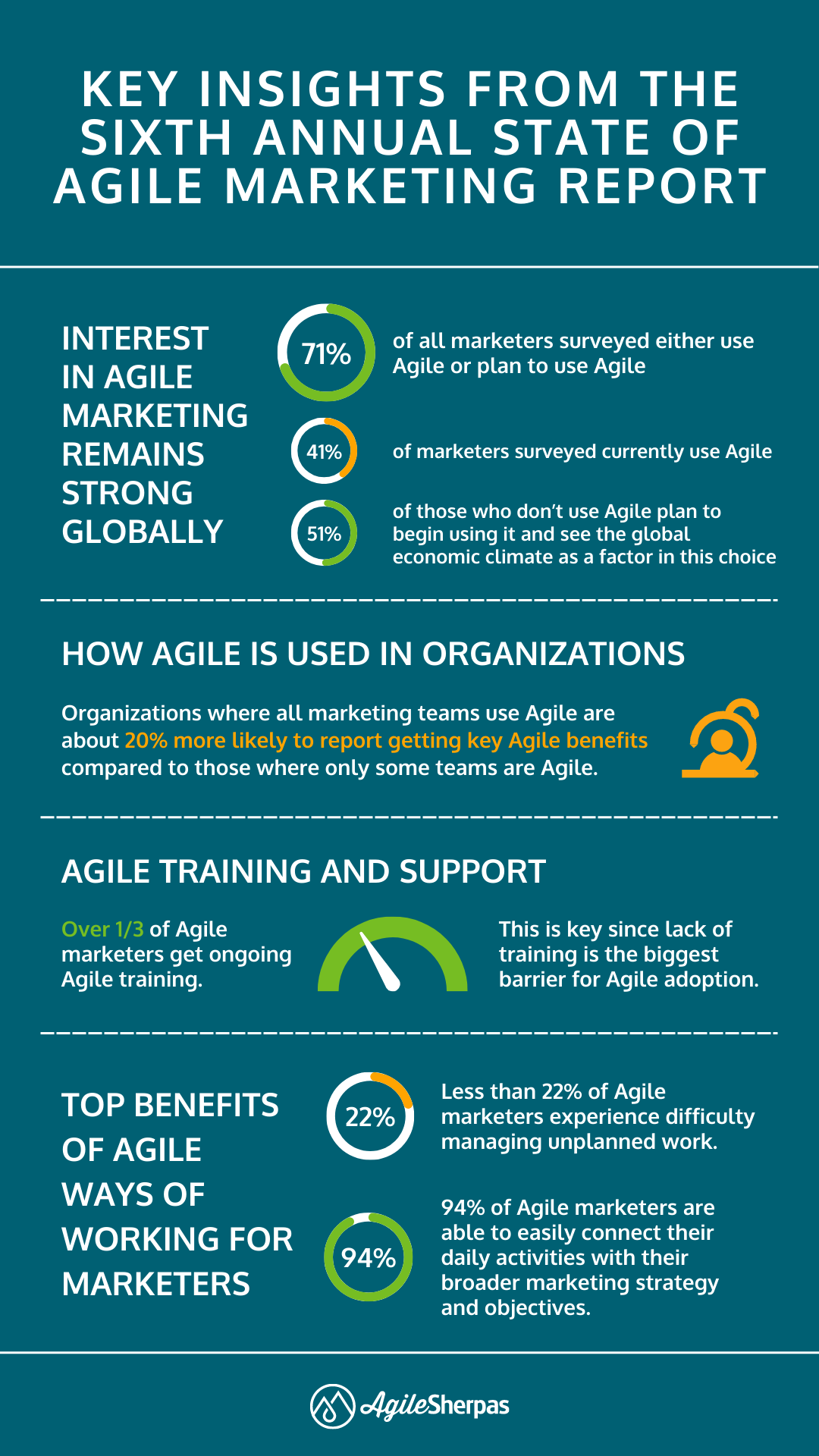Back in 2019, I saw a disturbing data point in our annual State of Agile Marketing Report.
Whereas we had previously seen marketers citing a lack of training and education as their main barrier to greater agility, for the first time, we saw the belief that current ways of working were “good enough” topping the list.
I was worried because complacency is a much more formidable foe than ignorance.
Then the pandemic happened, and marketers everywhere were instantly and painfully confronted with the inadequacy of the status quo.
Traditional ways of working didn’t stand a chance against the daily whiplash of the second quarter of 2020, and as the pandemic and its fallout just kept extending, those shortcomings only got clearer.
We saw upticks in Agile marketing adoption during and after the pandemic, and I hoped it had tempered marketers’ love of sticking with what we know.
But here we are again.
As the scope of our annual State of Agile Marketing Report expands in 2023 to reach more of the globe, we see once again the feeling that current processes are satisfactory topping the list of reasons why marketers aren’t more Agile.
A lack of training and education is still on the list, but only 25% of our respondents cited this reason, compared to 33% who think their current processes are fine.
So, I’m here to sound the alarm.
“Good enough” is likely not good enough for your customers, and it won’t be good enough to get you through the next major crisis. Hopefully, it won’t be COVID-level crazy, but there’s no way that it’s simply smooth sailing ahead.
Whether it’s an industry-specific crisis or a serious disruption in your target market, something’s coming to mess up your ways of working.
If you’re not planning to make a start on your Agile journey, you’re in danger of disruption.
If you’re using some Agile practices but not looking for ways to improve, you’re bound to backslide.
In the paragraphs that follow, I’ll take you on a deep dive into this year’s State of Agile Marketing Report, where we continue our annual tradition of unpacking what’s going on with marketing agility and what it means for you. I urge you to look for yourself in this data, and to use it to map your next move.
Doing what you’ve always done will get the same results you’ve always gotten… or maybe not even that, as the world moves ever faster. Regardless of what you do or who you do it for, there are better ways to get work done.
Table of Contents:
Before you dive in deeper, why don't you get your free copy of the latest State of Agile Marketing Report?
We Know What Works, Let’s Do That
While there’s no secret formula for agility, there is a known set of practical steps. You lay out a roadmap for your transformation, teach people about what’s expected of them, coach them as they apply that to their day-to-day work, equip them to sustain the change over the long term, and continually iterate on all that as you go.
A few key tools have been proven to work extremely well at all of these stages, but marketers seem hesitant to take full advantage of these resources.
The Right Kind of Agile Marketing Training Helps
For instance, 80% of marketers who’ve used certification courses have found them valuable, but just over one-third of Agile marketers report making use of them.
Likewise, marketers aren’t taking advantage of conferences, coaches, “train the trainer” programs, or self-paced learning opportunities, even though the majority of users found them helpful.
.png?width=624&height=328&name=The%20Right%20Kind%20of%20Agile%20Marketing%20Training%20Helps%20(2).png)
Yes, marketing is a unique discipline that requires some translation of traditional Agile practices.
But that doesn’t mean that we have to reinvent the wheel.
There are courses and coaches out there that can help make our lives easier (lots of them are here at AgileSherpas if you want an easy one-click way to find them). Why start from scratch?
I’ve advocated for a while that we don’t all need to be Scrum Masters, but that doesn’t mean we can’t all benefit from a shared learning experience. If you don’t have the budget to certify every single marketer, opt for some self-paced, asynchronous, lower-cost options.
All the things on this list are proven to work. Use them if you want to give your Agile adoption or transformation the best chance of success.
Bad Tools Make Agile Marketing Harder
Every year, there are one or two data points in our report that make me sad. Here’s the one for this year: the most popular digital tool for managing Agile marketing is some kind of spreadsheet.
If you’re trying to use a spreadsheet to manage your Agile work, please stop!
There’s a multitude of free or cheap options that will make your system exponentially more effective. Trello and Miro are both quick and easy choices with low price points; Asana, Jira, and Monday all ranked high with our respondents.
Use one of these and spend a few hours setting up a better support system. You’ll be amazed at what it gets you.
(Wondering if your tool is really holding you back? Our Agile Marketing Assessment will give you the facts).
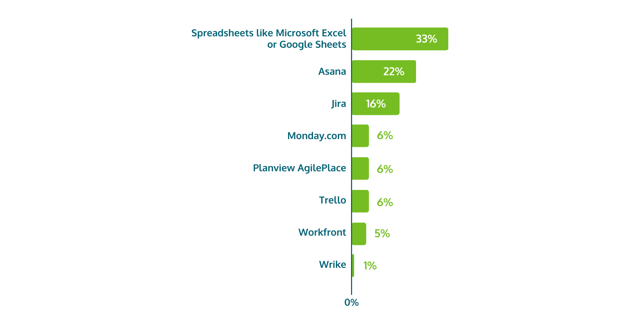
What Agile Marketers ARE Using
Based on how I opened this section, you might have thought that marketers are just stumbling around blindly on our Agile journey, but that’s not the case.
While we may not be taking full advantage of all the support options at our disposal, we are using some tools to help us.
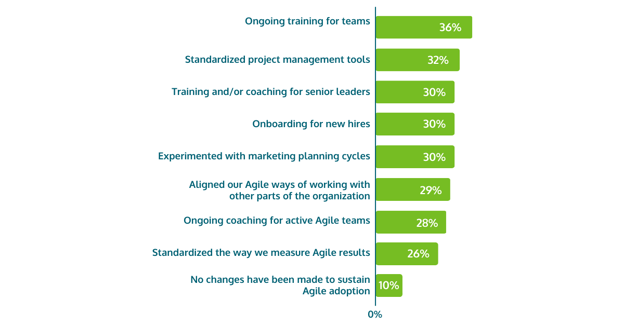
Marketers rely on training for teams and leaders, tool standardization, onboarding adjustments, and shifts in their planning cycles to support their Agile ways of working in the long term.
We’re using some of these tactics, but by using a more robust mix, we can maximize our investments and accelerate our ROI.
More Agile Teams = Better Outcomes
While we’re on the subject of obvious wins, we need to talk about the elephant in the room: one Agile team is alright, more Agile teams are way better.
This year, the data continues to speak for itself, revealing that marketing departments who shift all their teams to Agile ways of working far outperform their peers who keep agility isolated.
Eighty-three percent of the Agile marketers we surveyed work in organizations with more than one Agile team, which is a great start. But the real value is hiding on the other side of a complete, one-hundred percent shift to Agile.
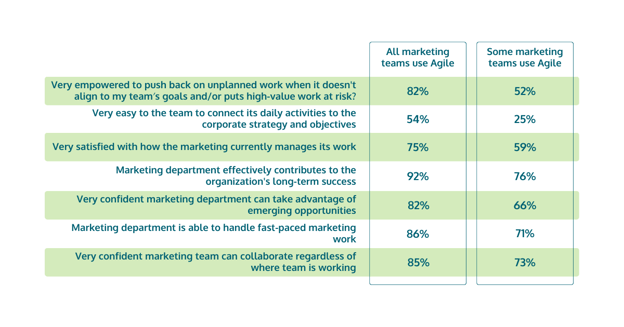
It turns out that when all marketing teams use Agile, you’re about 20% more likely to get key Agile benefits compared to outcomes when only some teams are Agile.
That’s a significant difference, but as of this year’s report, only about one-third of Agile marketers have managed to complete the full transformation.
Shifting one pilot team to Agile is a great start, but it’s just that – a start.
Marketing leaders must dig in and commit to seeing their departments through a full-scale transformation if they want to enjoy the full scope of benefits. (If this sounds scary or overwhelming, don’t worry – that’s what Agile transformation consultants are for. You can talk to one here).
Life is Better When Everyone is Agile
As you might imagine, once marketers get a taste of agility, they only want more. This is the second year we asked them how they feel about other parts of the business going Agile, and the results are pretty consistent.
A whopping ninety percent of our Agile respondents think it’s important for other functions to transition as well.
How important is it to the success of your marketing efforts that other departments adopt Agile ways of working?
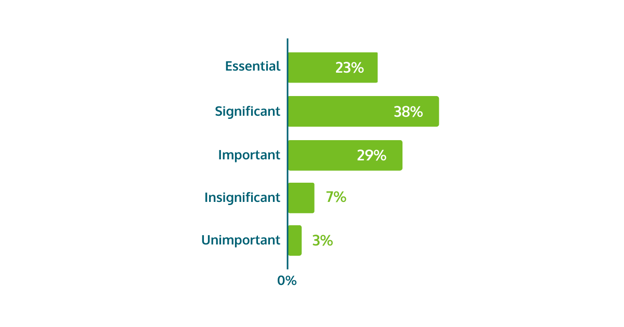
Fortunately, marketers seem likely to get their wish, although maybe not in the timeframe they’d like. We saw solid year-over-year increases in adoption for most non-marketing functions, with sales continuing to lead the way.
Could agility be our best route to finally and fully aligning the marketing and sales functions?!?
Which other functions in your organization are using an Agile methodology?
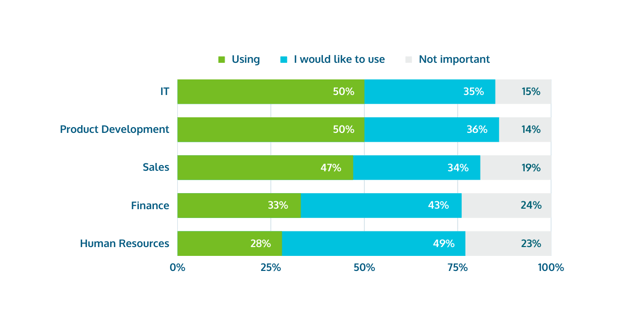
How to Manage Common Agile Marketing Challenges
Of course, it wouldn’t be the annual deep dive if we didn’t acknowledge the lingering challenges that Agile marketers face. Agile isn’t a magic pill; there are still things that aren’t perfect, no matter how beautiful your Kanban board is.
Agile marketers continue to struggle with our two-headed nemesis, unplanned work and changing plans, as well as people backsliding into non-Agile ways (likely because they couldn’t figure out how to deal with all the unplanned work).
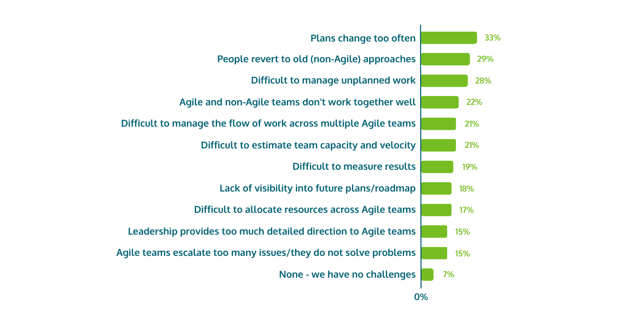
If you’re struggling with your own set of challenges, I have these tips to offer:
- Visualize Everything. Don’t limit your boards to high-priority projects. Make sure all the work from all possible sources gets visualized. Most struggles over unplanned work originate because things remained invisible for too long, so over-index on getting things onto a board (not a spreadsheet!).
- Get Stakeholders to Talk. Similarly, if you’re getting a bunch of work thrown at you from several different groups, chances are they don’t know that other people are also making demands on your time. Get them into a room and show them your board. Help them understand what’s possible and where they need to become prioritization partners. Remember, working on less actually allows you to accomplish more.
- Get Coaching to Prevent Backsliding. Training is great, but it’s finite. Coaching typically extends for multiple months or even years and will support people as they apply what they learned in a classroom or Zoom room. Invest in a coach with real-world experience, and don’t expect new Agilists to learn as they go while also coaching their colleagues.
Secrets of the Best Agile Marketers
I want to close by clearly outlining the “secrets” from our annual report. I use quotation marks intentionally here because none of these are really secrets. But the beauty of data collection and analysis through tools like this report is that we get data-driven validation of what we see every day with our clients.
So, if you’re wondering what the key success factors for marketing agility are, I’m here to let you in on the secret.

Successful Agile marketers are more likely to:
- Have undergone a full Agile transformation. This means they’ve done the hard work of reorganizing according to Agile principles, piloted and tested Agile team composition, trained everyone on best practices, enabled leaders to sponsor the change, and generally shifted their entire department to run on Agile. A single pilot team is great, but it’s not the end of the journey.
- Use Sprint planning to map out short-term work. Breaking work up into bite-sized pieces, in which each “bite” is about two weeks long, helps maintain focus while allowing for flexibility. It’s a beautiful best practice.
- Lean into training. This includes certifications, working with Agile coaches, and delivering “train the trainer” programs to their internal change agents, responsible for ensuring Agile sticks around.
- Be part of organizations that continuously support Agile. Whether it’s long-term coaching, continuous learning opportunities, or real-time access to materials, successful Agilists don’t confine their change to a two-day workshop.
- Standardize their success metrics. Every Agile team knows what good looks like and how close they are to getting there. It’s not a competition, but everyone’s clear on what the targets are.
- Align their ways of working with other parts of the organization. Even if marketers adopt certain practices to fit their needs, the successful ones keep organizational needs in mind. Whether joining release planning sessions or syncing up their sprints, they’re willing to do the work to align all processes.
- Shift the way they plan. Having dynamic, fast-moving, Agile marketing teams who are trying to execute on a static, unchanging annual plan is a waste of time and a source of perpetual frustration. Best-in-class marketers are evolving planning cycles to align with their Agile goals.
- Budget differently. Just as static annual plans don’t jive with Agile teams, big-bang budgets don’t work either. The most successful Agilists work with financial partners to gain the flexibility they need for just-in-time funding when and where it makes sense.
This Year’s Global Respondents
In closing, I need to acknowledge one of the most significant shifts in this year’s report: its global reach. We’ve long talked about how and when to get beyond our usual group of North American respondents, and this year we got it done.
We translated our survey into Spanish, French, and German and worked diligently with our partners to ensure a more globally representative pool of respondents.
As Agile marketing makes its way around the globe, it’s vital that our report reflects that growing diversity of experience. We’re proud to share this more nuanced view this year and intend to keep extending and expanding the perspectives we represent.
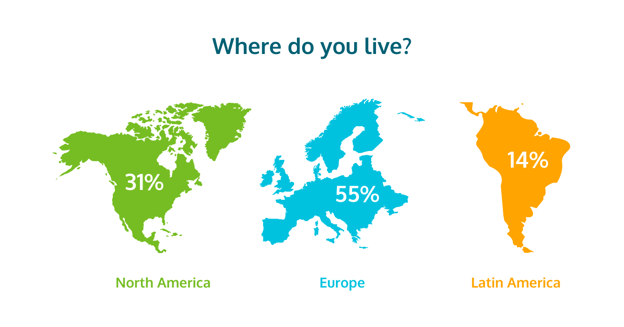
Where to Now?
Every year this deep dive has its ups and downs; this year is no exception.
Marketers are driving adoption in other non-software teams… but we aren’t taking advantage of the full scope of support options available to us.
Agile is helping us achieve our highest priorities… but few of us have gotten all our marketers on board.
While there are highs and lows on every climb, the overall trajectory remains positive. In my sixth year of exploring this data, I remain encouraged that agility can keep driving continuous improvement in the marketing profession.
Marketers will keep pushing, keep driving, and keep leading the way until all our colleagues have adopted Agility and are happily building backlogs and finding more joy in their workdays.
